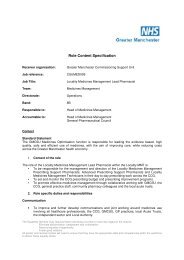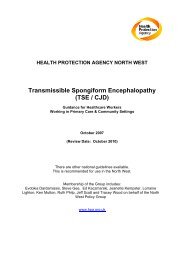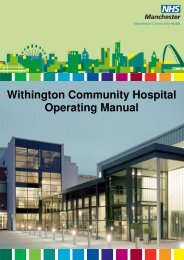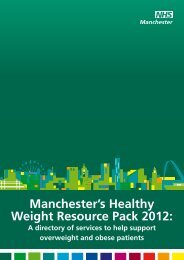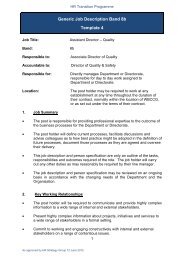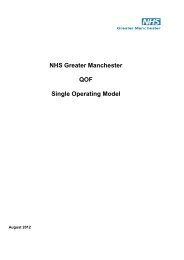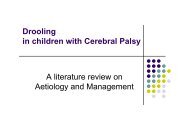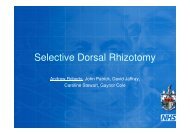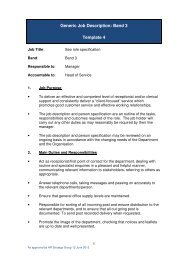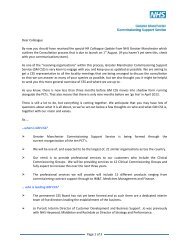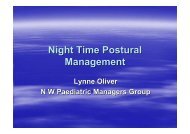Bruising in CP
Bruising in CP
Bruising in CP
Create successful ePaper yourself
Turn your PDF publications into a flip-book with our unique Google optimized e-Paper software.
A pilot study to test the<br />
methodology for the <strong>in</strong>vestigation<br />
of the prevalence and distribution<br />
of bruis<strong>in</strong>g <strong>in</strong> children with<br />
cerebral palsy.<br />
Diana Jell<strong>in</strong>ek<br />
Therese Bennett<br />
May 2008<br />
1
The evidence: <strong>in</strong>tentional <strong>in</strong>juries<br />
to children<br />
www.core-<strong>in</strong>fo.cf.ac.uk<br />
2
Rationale<br />
• A systematic review of studies exam<strong>in</strong><strong>in</strong>g the<br />
prevalence and distribution of bruis<strong>in</strong>g <strong>in</strong><br />
able-bodied children and babies has provided<br />
some <strong>in</strong>formation on size, distribution and<br />
frequency of bruis<strong>in</strong>g <strong>in</strong> children 1 .<br />
1. Maguire S, Mann MK, Kemp A. Are there patterns of bruis<strong>in</strong>g <strong>in</strong><br />
childhood which are diagnostic or suggestive of abuse A<br />
systematic review. Arch Dis Child 2005; 90: 182-86.<br />
3
Rationale<br />
• There are no published studies<br />
describ<strong>in</strong>g patterns of bruis<strong>in</strong>g <strong>in</strong><br />
children with disabilities.<br />
• The aims of this study were:<br />
– To test a method to ensure acceptability to children<br />
with <strong>CP</strong> and their parents.<br />
– To document any bruises seen by number, size and<br />
location.<br />
– To exam<strong>in</strong>e bruis<strong>in</strong>g patterns <strong>in</strong> children with <strong>CP</strong> <strong>in</strong><br />
order to provide a basel<strong>in</strong>e for future studies.<br />
7
Def<strong>in</strong>itions<br />
Cerebral palsy (<strong>CP</strong>)<br />
“an umbrella term cover<strong>in</strong>g a group of non-progressive but<br />
often chang<strong>in</strong>g motor impairment syndromes secondary to<br />
lesions or anomalies of the bra<strong>in</strong> aris<strong>in</strong>g <strong>in</strong> the early stages<br />
of its development” 2<br />
Bruise<br />
A bruise is an traumatic <strong>in</strong>jury of the soft tissues which<br />
results <strong>in</strong> breakage of the local capillaries and leakage of red<br />
blood cells. In the sk<strong>in</strong> it can be seen as a reddish-purple<br />
discoloration that does not blanch when pressed upon. When a<br />
bruise fades it becomes green and brown as the body<br />
metabolizes the blood cells <strong>in</strong> the sk<strong>in</strong>.<br />
Websters Medical Dictionary<br />
2. Mutch L, Ronal E. The Scottish Register of Children with a Motor Deficit of Central Orig<strong>in</strong>. Report to the<br />
Chief Scientist (Scotland)<br />
K/OPR/2/2/C929. Glasgow University, Public Health Research Unit.<br />
8
Method<br />
• Children with <strong>CP</strong>, aged 2-11, attend<strong>in</strong>g 2<br />
Manchester specialist support schools.<br />
• 4 paediatricians.<br />
• Full sk<strong>in</strong> exam<strong>in</strong>ation and record<strong>in</strong>g of marks<br />
on a body chart, as part of the rout<strong>in</strong>e medical.<br />
• Number, size and location of marks to be<br />
recorded.<br />
• An assessment of developmental level to be<br />
made, <strong>in</strong>clud<strong>in</strong>g use of GMFCS.<br />
• An explanation to be sought from child or<br />
carer for any bruises seen.<br />
9
Method<br />
• Bruises seen that raise a concern about nonaccidental<br />
<strong>in</strong>jury to be dealt with <strong>in</strong> the same<br />
way as concerns aris<strong>in</strong>g <strong>in</strong> any medical<br />
exam<strong>in</strong>ation, (Manchester Safeguard<strong>in</strong>g<br />
Children’s Board policy).<br />
• Pilot study approved by LREC<br />
• Analysis of the process and the results was<br />
undertaken by the ma<strong>in</strong> <strong>in</strong>vestigator who was<br />
not be <strong>in</strong>volved <strong>in</strong> the cl<strong>in</strong>ical assessments.<br />
10
data collection form<br />
Mobility (us<strong>in</strong>g GMFM classification system):<br />
Level 1 2 3 4 5<br />
Hand function:<br />
Normal - can play/write/draw etc<br />
Mild - some difficulty with play/write/draw e.g unstead<strong>in</strong>ess, awkward release,<br />
Moderate – considerable difficulty with play/write/draw, requires<br />
Severe - Unable to use hand but can use switch system<br />
Profound - unable to use switch system<br />
11
Gross Motor Function Classification<br />
System<br />
Between 6th and 12th Birthday<br />
Level I Children walk and climb stairs without limitations. Children can<br />
run and jump but speed, balance, and coord<strong>in</strong>ation are reduced.<br />
Level II Children walk and climb stairs hold<strong>in</strong>g onto a rail<strong>in</strong>g but<br />
experience limitations walk<strong>in</strong>g on uneven surfaces and <strong>in</strong>cl<strong>in</strong>es.<br />
Children have m<strong>in</strong>imal ability to run and jump.<br />
Level III Children walk on a level surface with an assistive mobility<br />
device. Children may climb stairs hold<strong>in</strong>g onto a rail<strong>in</strong>g. Children<br />
propel a wheelchair manually or are transported long distances or<br />
outdoors on uneven terra<strong>in</strong>.<br />
Level IV Children may ma<strong>in</strong>ta<strong>in</strong> levels of function achieved before age<br />
6 or rely more on wheeled mobility at home, school, and <strong>in</strong> the<br />
community. Children may achieve self-mobility us<strong>in</strong>g a power<br />
wheelchair.<br />
Level V Physical impairments restrict voluntary control of movement<br />
and the ability to ma<strong>in</strong>ta<strong>in</strong> antigravity head and trunk postures. All<br />
areas of motor function are limited. Functional limitations <strong>in</strong> sitt<strong>in</strong>g<br />
and stand<strong>in</strong>g are not fully compensated for through the use of<br />
adaptive equipment and assistive technology. At level V, children<br />
have no means of <strong>in</strong>dependent mobility and are transported. Some<br />
children achieve self-mobility us<strong>in</strong>g a power wheelchair with<br />
extensive adaptations.
Results<br />
• 38 children eligible<br />
• 20 children seen (Nov 2006 to Dec 2007)<br />
• 18 boys<br />
• Ages 3-12 (mean 7)<br />
• Paediatric nurses very supportive (essential<br />
as knew children and parents very well)<br />
• Parents very supportive of study and had no<br />
problems with methodology.<br />
14
Bruises: n=32 <strong>in</strong> 12 children<br />
15
Marks: n=49 <strong>in</strong> 12 children<br />
16
Bruises and mobility (n=12)<br />
Child’s Level of mobility on<br />
GMFCS ( 1 – 5)<br />
Number of bruises<br />
5 1<br />
5 2<br />
5 2<br />
5 5*<br />
5 6*<br />
4 7<br />
4 2<br />
4 1<br />
4 1<br />
2 2<br />
2 2<br />
1 1<br />
* Children with <strong>in</strong>voluntary movements<br />
17
Weight<br />
≤ 0.4 centile >0.4 ≤50 centile >50 ≤98 centile<br />
Number of<br />
children<br />
Number of<br />
children with<br />
bruises<br />
Total number of<br />
bruises<br />
8 7 4<br />
5 3 3<br />
17 9 4<br />
18
Summary<br />
• Non-ambulant children <strong>in</strong> this pilot had a<br />
substantial number of bruises unlike nonambulant<br />
able-bodied <strong>in</strong>fants.<br />
• The methodology was acceptable (although<br />
time consum<strong>in</strong>g) to children, their parents and<br />
the exam<strong>in</strong>ers.<br />
• The measur<strong>in</strong>g template was easy to use.<br />
• A multi centre study is be<strong>in</strong>g designed,<br />
recruit<strong>in</strong>g approximately 250 children, to<br />
ascerta<strong>in</strong> the prevalence and distribution of<br />
bruis<strong>in</strong>g <strong>in</strong> children with cerebral palsy.<br />
19




